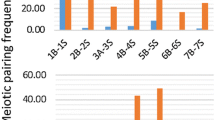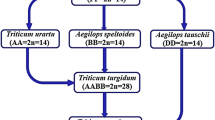Abstract
Triticum timopheevii (2n = 4x = 28, GGAtAt) is a tetraploid wheat formerly cultivated in western Georgia. The natural allopolyploid Triticum zhukovskyi is a hexaploid taxon originated from hybridization of T. timopheevii with cultivated einkorn T. monococcum (2n = 2x = 14, AmAm). Karyotypically T. timopheevii and T. zhukovskyi differ from other tetraploid and hexaploid wheats and were assigned to the section Timopheevii of the genus Triticum L. Triticum timopheevii and T. zhukovskyi are resistant to many fungal diseases and therefore could potentially be utilized for wheat improvement. We were aiming to precisely identify all T. timopheevii chromosomes and to trace the evolution of T. zhukovskyi. For this, we developed a set of molecular cytogenetic landmarks based on eleven DNA probes. Each chromosome can now be characterized by two to eight probes. The pTa-535 sequence allows the identification of all At-genome chromosomes, whereas G-genome and some At-genome chromosomes can be identified using (GAA/CTT) n and pSc119.2 probes. The probes pAesp_SAT86, pAs1, Spelt-1, Spelt-52 and 5S and 45S rDNA can be applied as additional markers to discriminate particular chromosomes or chromosomal regions. The distribution of (GAA/CTT) n , pTa-535 and pSc119.2 DNA probes on T. timopheevii chromosomes is distinct from other tetraploid wheats and can therefore be used to track individual chromosomes in introgression programs. Our study confirms the origin of T. zhukovskyi from hybridization of T. timopheevii with T. monococcum; however, we show that the emergence was accompanied by changes involving mostly At-genome chromosomes. This may be due to the presence of two closely related A-genomes in the T. zhukovskyi karyotype.






Similar content being viewed by others

References
Allaby RG, Brown TA (2000) Identification of a 5S rDNA spacer type specific to Triticum urartu and wheats containing the T. urartu genome. Genome 43:250–254. doi:10.1139/g99-122
Allard RW, Shands RG (1954) Inheritance of resistance to stem rust and powdery mildew in cytologically stable spring wheats derived from Triticum timopheevii. Phytopathology 44:266–274
Badaeva ED (2001) Chromosome analysis in the investigation of the origin of B-(G-) genomes of polyploid wheats. Membr Cell Biol 18:216–229 [in Russian]
Badaeva ED, Shkutina FM, Bogdevich IN, Badaev NS (1986) Comparative study of Triticum aestivum and T. timopheevii genomes using C-banding technique. Pl Syst Evol 154:183–194. doi:10.1007/BF00990122
Badaeva ED, Budashkina EB, Badaev NS, Kalinina NP, Shkutina FM (1991) General features of chromosome substitutions in Triticum aestivum × T. timopheevii hybrids. Theor Appl Genet 82:227–232. doi:10.1007/BF00226218
Badaeva ED, Badaev NS, Gill BS, Filatenko AA (1994a) Intraspecific karyotype divergence in Triticum araraticum (Poaceae). Pl Syst Evol 192:117–145. doi:10.1007/BF00985912
Badaeva ED, Filatenko AA, Badaev NS (1994b) Cytogenetic investigation of Triticum timopheevii (Zhuk.) Zhuk. and related species using C-banding. Theor Appl Genet 89:622–628. doi:10.1007/BF00222457
Badaeva E, Zoshchuk S, Paux E, Gay G, Zoshchuk N, Roger D, Zelenin A, Bernard M, Feuillet C (2010) Fat element—a new marker for chromosome and genome analysis in the Triticeae. Chrom Res 18:697–709. doi:10.1007/s10577-010-9151-x
Badaeva ED, Amosova AV, Goncharov NP, Macas J, Ruban AS, Grechishnikova IV, Zoshchuk SA, Houben A (2015) A set of cytogenetic markers allows the precise identification of all A-genome chromosomes in diploid and polyploid wheat. Cytogenet Genome Res 146:71–79. doi:10.1159/000433458
Bedbrook RJ, Jones J, O’Dell M, Thompson RJ, Flavell RB (1980) A molecular description of telomeric heterochromatin in Secale species. Cell 19:545–560. doi:10.1016/0092-8674(80)90529-2
Bowden WM (1959) The taxonomy and nomenclature of the wheats, barleys and ryes and their relatives. Canad J Bot 37:657–684. doi:10.1139/b59-053
Cuadrado A, Cardoso M, Jouve N (2008) Increasing the physical markers of wheat chromosomes using SSRs as FISH probes. Genome 51:809–815. doi:10.1139/G08-065
Dekaprelevich LL, Menabde VL (1932) Hulled wheat in Western Georgia. Bull Appl Bot Genet Plant Breed 5:1–46 [in Russian]
Dobrovolskaya O, Sourdille P, Bernard M, Salina E (2009) Chromosome synteny of the A genome of two evolutionary wheat lines. Russ J Genet 45:1368–1375. doi:10.1134/S1022795409110118
Dobrovolskaya O, Boeuf C, Salse J, Pont C, Sourdille P, Bernard M, Salina E (2011) Microsatellite mapping of Ae. speltoides and map-based comparative analysis of the S, G, and B genomes of Triticeae species. Theor Appl Genet 123:1145–1157. doi:10.1007/s00122-011-1655-z
Dorofeev VF, Filatenko AA, Migushova EF, Udachin RA, Jakubziner MM (1979) Cultivated flora of the USSR. In: Brezhnev DD (ed) Wheat, vol 1. Kolos (Leningrad branch), Leningrad [in Russian]
Dvořák J, Diterlizzi P, Zhang HB, Resta P (1993) The evolution of polyploid wheats—identification of the A-genome donor species. Genome 36:21–31. doi:10.1139/g93-004
Gerlach WL, Bedbrook JR (1979) Cloning and characterization of ribosomal RNA genes from wheat and barley. Nucleic Acid Res 7:1869–1885. doi:10.1093/nar/7.7.1869
Gerlach WL, Dyer TA (1980) Sequence organization of the repeated units in the nucleus of wheat which contains 5S-rRNA genes. Nucleic Acid Res 8:4851–4865. doi:10.1093/nar/8.21.4851
Gill BS, Chen PD (1987) Role of cytoplasm-specific introgression in the evolution of the polyploid wheats. Proc Natl Acad Sci USA 84:6800–6804. doi:10.1073/pnas.84.19.6800
Gill KS, Gill BS, Snyder EB (1988) Triticum araraticum chromosome substitutions in common wheat, Triticum aestivum cv. Wichita. In: Miller TE, Koebner RMD (eds) Proceedings of the 7th International Wheat Genetics Symposium, 13–19 July 1988. Bath Press, Avon, Cambridge, England, pp 87–92
Gornicki P, Zhu H, Wang J, Challa GS, Zhang Z, Gill BS, Li W (2014) The chloroplast view of the evolution of polyploid wheat. New Phytol 204:704–714. doi:10.1111/nph.12931
Huang S, Sirikhachornkit A, Su X, Faris J, Gill B, Haselkorn R, Gornicki P (2002) Genes encoding plastid acetyl-CoA carboxylase and 3-phosphoglycerate kinase of the Triticum/Aegilops complex and the evolutionary history of polyploid wheat. Proc Natl Acad Sci USA 99:8133–8138. doi:10.1073/pnas.072223799
Hutchinson J, Miller TE, Jahier J, Shepherd KW (1982) Comparison of the chromosomes of Triticum timopheevii with related wheats using the techniques of C-banding and in situ hybridization. Theor Appl Genet 64:31–40. doi:10.1007/BF00303647
Jakobson I, Reis D, Tiidema A, Peusha H, Timofejeva L, Valárik M, Kladivová M, Šimková H, Doležel J, Järve K (2012) Fine mapping, phenotypic characterization and validation of non-race-specific resistance to powdery mildew in a wheat–Triticum militinae introgression line. Theor Appl Genet 125:609–623. doi:10.1007/s00122-012-1856-0
Jiang J, Gill BS (1993) Sequential chromosome banding and in situ hybridization analysis. Genome 36:792–795. doi:10.1139/g93-104
Jiang J, Gill BS (1994a) Different species-specific chromosome translocations in Triticum timopheevii and T. turgidum support the diphyletic origin of polyploid wheats. Chrom Res 2:59–64. doi:10.1007/BF01539455
Jiang J, Gill BS (1994b) New 18S-26S ribosomal RNA gene loci: chromosomal landmarks for the evolution of polyploid wheats. Chromosoma 103:179–185. doi:10.1007/BF00368010
Kilian B, Özkan H, Deusch O, Effgen S, Brandolini A, Kohl J, Martin W, Salamini F (2007) Independent wheat B and G genome origins in outcrossing Aegilops progenitor haplotypes. Molec Biol Evol 24:217–227. doi:10.1093/molbev/msl151
Kilian B, Özkan H, Pozzi C, Salamini F (2009) Domestication of the Triticeae in the Fertile Crescent. In: Muehlbauer GJ, Feuillet C (eds) Genetics and genomics of the Triticeae. Springer, New York, pp 81–119. doi:10.1007/978-0-387-77489-3_3
Knüpffer H (2009) Triticeae genetic resources in ex situ genebank collections. In: Muehlbauer GJ, Feuillet C (eds) Genetics and genomics of the Triticeae. Springer, New York, pp 31–79. doi:10.1007/978-0-387-77489-3_2
Komuro S, Endo R, Shikata K, Kato A (2013) Genomic and chromosomal distribution patterns of various repeated DNA sequences in wheat revealed by a fluorescence in situ hybridization procedure. Genome 56:131–137. doi:10.1139/gen-2013-0003
Kuz’menko SP, Ataeva DM, Gandilian PA (1989) Comparative investigation of the diploid wheat genomes using differential chromosome staining. Russ J Genet 23:686–692
Leonova I, Röder M, Kalinina N, Budashkina E (2008) Genetic analysis and localization of loci controlling leaf rust resistance of Triticum aestivum × Triticum timopheevii introgression lines. Russ J Genet 44:1431–1437. doi:10.1134/S1022795408120077
McIntosh RA, Yamazaki Y, Dubcovsky G, Rogers J, Morris CF, Appels R, Xia XC (2013) Catalogue of Gene Symbols for Wheat. In: 12th International Wheat Genetics Symposium, 8–13 Sept 2013, Yokohama, Japan, p 395
Menabde VL, Ericzjan AA (1960) To the investigation of Georgian wheat Zanduri. Proc Georg Acad Sci 25:731–732 [in Georgian]
Mikó P, Megyeri M, Farkas A, Molnár I, Molnár-Láng M (2015) Molecular cytogenetic identification and phenotypic description of a new synthetic amphiploid, Triticum timococcum (AtAtGGAmAm). Genet Res Crop Evol 62:55–66. doi:10.1007/s10722-014-0135-0
Mori N, Kondo Y, Ishii T, Kawahara T, Valkoun J, Nakamura C (2009) Genetic diversity and origin of timopheevi wheat inferred by chloroplast DNA fingerprinting. Breed Sci 59:571–578. doi:10.1270/jsbbs.59.571
Pedersen C, Langridge P (1997) Identification of the entire chromosome complement of bread wheat by two-colour FISH. Genome 40:589–593. doi:10.1139/g97-077
Rayburn AL, Gill BS (1986) Isolation of a D-genome specific repeated DNA sequence from Aegilops squarrosa. Pl Molec Biol Rep 4:104–109. doi:10.1007/BF02732107
Rodríguez S, Perera E, Maestra B, Díez M, Naranjo T (2000) Chromosome structure of Triticum timopheevii relative to T. turgidum. Genome 43:923–930. doi:10.1139/g00-062
Salina EA, Pestsova EG, Adonina IG, Vershinin AV (1998) Identification of a new family of tandem repeats in Triticeae genomes. Euphytica 100:231–237. doi:10.1023/A:1018360324242
Salina EA, Adonina IG, Vatolina TY, Kurata N (2004) A comparative analysis of the composition and organization of two subtelomeric repeat families in Aegilops speltoides Tausch and related species. Genetica 122:227–237. doi:10.1007/s10709-004-5602-7
Salina EA, Leonova IN, Efremova TT, Röder MS (2006a) Wheat genome structure: translocations during the course of polyploidization. Funct Integr Genomics 6:71–80. doi:10.1007/s10142-005-0001-4
Salina EA, Lim YK, Badaeva ED, Scherban AB, Adonina IG, Amosova AA, Samatadze TE, Vatolina TY, Zoshchuk SA, Leitch AR (2006b) Phylogenetic reconstruction of Aegilops section Sitopsis and the evolution of tandem repeats in the diploids and derived wheat polyploids. Genome 49:1023–1035. doi:10.1139/g06-050
Tsunewaki K (1996) Plasmon analysis as the counterpart of genome analysis. In: Jauhar PP (ed) Methods of genome analysis in plants: their merits and pitfalls. CRC Press, Boca Raton, pp 271–299
Upadhya MD, Swaminathan MS (1965) Studies on the origin of T. zhukovskyi and on the mechanisms regulating chromosome pairing in Triticum. Indian J Genet Pl Breed 25:1–13
Yamamori M (1994) An N-band marker for gene Lr18 for resistance to leaf rust in wheat. Theor Appl Genet 89:643–646. doi:10.1007/BF00222461
Zhukovsky PM (1924) Wild emmer in Georgia—Triticum dicoccum Schrank dicoccoides Koern. Notes Appl-Sci Dept Tiflis Bot Garden 3:1–3 [in Russian]
Zoshchuk S, Badaeva E, Zoshchuk N, Adonina I, Shcherban’ A, Salina E (2007) Intraspecific divergence in wheats of the Timopheevi group as revealed by in situ hybridization with tandem repeats of the Spelt1 and Spelt52 families. Russ J Genet 43:636–645. doi:10.1134/S1022795407060063
Acknowledgments
We thank Drs. H. Bockelman (USDA-ARS, Aberdeen, Idaho, USA), B. S. Gill (Wheat Genetics and Genomic Resource Centre, Kansas State University, USA), T. Kawahara (Kyoto University, Kyoto, Japan), J. Valkoun [International Center for Agricultural Research in the Dry Areas (ICARDA), Aleppo, Syria], A. Graner [Leibniz Institute of Plant Genetics and Crop Plant Research (IPK), Gatersleben, Germany], G. Fedak (Eastern Cereal and Oilseed Research Centre, Agriculture and Agri-Food Canada, Canada), I. M. Matitashvili (Botanical Institute, Tbilisi, Georgia), Z. Yakobashvili (Tbilisi Agricultural Institute, Tbilisi, Georgia), O. P. Mitrofanova [Vavilov Institute of Plant Genetic Resources (VIR), St. Petersburg, Russia], E. B. Budashkina and N. P. Goncharov (Institute of Cytology and Genetics, Siberian Branch of the Russian Academy of Sciences, Novosibirsk, Russia) and V. S. Rubtsova (Russian State Agrarian University—Moscow Timiryazev Agricultural Academy, Moscow, Russia) for providing the material for our analysis. This work was supported by the Russian State Foundation for Basic Research (projects 14-04-00142, 14-04-00247), State Budget Project and the Program “Dynamics and Preservation of Gene Pools” from the Presidium of the Russian Academy of Sciences.
Author information
Authors and Affiliations
Corresponding author
Ethics declarations
Conflict of interest
The authors declared that they have no conflict of interest.
Additional information
Handling editor: Martin Lysak.
Rights and permissions
About this article
Cite this article
Badaeva, E.D., Ruban, A.S., Zoshchuk, S.A. et al. Molecular cytogenetic characterization of Triticum timopheevii chromosomes provides new insight on genome evolution of T. zhukovskyi . Plant Syst Evol 302, 943–956 (2016). https://doi.org/10.1007/s00606-016-1309-3
Received:
Accepted:
Published:
Issue Date:
DOI: https://doi.org/10.1007/s00606-016-1309-3



